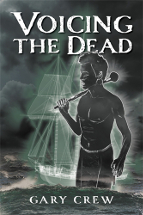Voicing the dead by Gary Crew

Ford Street, [2015]. ISBN 9781925272055
Gary Crew is known for his interest in confronting historical events
which form the basis for novels. In this tale, the author revisits a
topic covered in an earlier work, being the true story of the wreck
of the Charles Eaton on a reef in the Torres Strait in 1834.
A bold technique, described in the text as 'Lit tripping' enables
the narrator, 14 year old Jack Ireland, (the voice of the dead) to
time skip through centuries of literature, quoting passages to
better describe the terrifying events which befall the crew and
passengers from the vessel. Interestingly, whilst recounting events
from the past, the character references authors writing long after
his death, a style emphasising ghostly, tormented afterlife which
may confuse some readers in this overly long story.
In a similar break from tradition, Crew reveals in the initial pages
that the ship is wrecked and the crew and passengers are murdered by
head-hunters. Together with an orphaned toddler William D'Oyley,
ship's cabin boy Jack survives to tell his tale in a monstrously
edited version produced by a London publisher in 1845.
Having revealed the plot and conclusion, the author skilfully
entices the reader to accompany Jack from his appearance on the
vessel whilst loading in London to undertaking the arduous journey
to Tasmania where cargo and poor Irish orphans are delivered to
Hobart's docks. During the passage, Jack struggles to establish his
place in the ship, enjoying a privileged position as Captain's boy
which causes tension with the seamen as he tends to both his master
and the orphans who have endured grim suffering. Importantly, Jack
comes to hero worship the thoroughly decent and brave First Mate,
Mr. Clare, who will have great influence over the lad and the crew
following the wreck.
Sailing North, the vessel passes into the Torres Strait, heading for
Java when it strikes a reef, becoming so damaged that it has to be
abandoned. A range of curious circumstances concerning the order of
departure occur but the end result is that the passengers and most
of the crew save themselves by building rafts which are washed up on
shores inhabited by head-hunters.
The murderous savagery which follows is confronting and disturbing,
to the extent that whilst admiring Crew's capacity to move and
influence through words, I struggled to identify an appropriate
readership given that the novel lacks depth for senior literary
study. The plight of baby William, seeing his parents brutally
beaten and beheaded is awful, but just one element amongst many
hideous aspects which are sadly true. The passage of time should not
inure the reader to suffering, especially in works designed for
amusement and entertainment.
Rob Welsh
Editor's note: The publisher recommends it as Age 15+. Teacher's
notes are available.